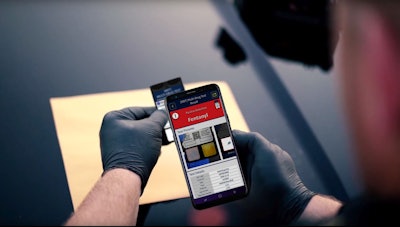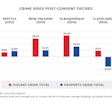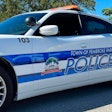![[|CREDIT|]](https://img.policemag.com/files/base/bobit/publicsafety/image/2019/05/pm.mobiledetectopening-pic_edit_detectachem.jpg?auto=format%2Ccompress&fit=max&q=70&w=400)
Law enforcement officers must be ready for anything whether out on patrol or working special assignments. When they suspect the presence of narcotics, officers can use presumptive drug tests to determine whether illicit drugs are present practically anywhere they need to.
These tests, which can be used for bulk or trace amounts, don't typically indicate a specific level of drug, but they provide a positive or negative result for a drug or drug class. Later, a definitive drug test can identify specific drugs or metabolites and be used to confirm the initial test.
Benefits
Those in law enforcement who can benefit from using these tests include patrol officers, troopers, border protection, and members of drug and gang units. Presumptive drug tests are useful for drug field testing on traffic stops, evidence testing, interdiction, contraband or mail inspection, trash pulls, and even personal protection screening to determine exposure to different substances. Trace amounts of drugs could be found on drug packaging as well as clothing, paper, and various drug paraphernalia. They could also be found pretty much anywhere in a clandestine lab.
Of course, K-9s trained to sniff for drugs can also be used. But let's take a look at how individual officers can test for drugs on their own.
Safety First
Whatever method of substance identification you're using, safety comes first. Always carry appropriate gloves and respiratory protection—that you're sure fit you properly—where you can easily access them. Be trained in how to use them and remove them, and be sure to use them whenever you suspect a hazardous substance. Also be careful to limit exposure as much as possible, even when wearing protective gear.
![[|CREDIT|]](https://img.policemag.com/files/base/bobit/publicsafety/image/2019/05/pm.md-step2_cocainetest_detectachem.jpg?auto=format%2Ccompress&fit=max&q=70&w=400)
"Fentanyl has really changed a lot of the landscape in drug field testing," says Greg Giuntini, director of market development for DetectaChem. "A lot of agencies don't test as much as they used to for fear of contaminating their officers." But properly using protection and following proper technique for testing can minimize officer exposure to potentially dangerous substances.
Methods
Methods used to detect narcotics differ. For officers out in the field, there are various portable testing solutions to choose from.
Many portable drug detection tests rely on reagents, or "reactive agents," to determine the presence or absence of a substance in a sample. During a test, reagent is combined with a very small amount of the substance. The structure of the unknown sample is then altered through unique mechanisms, resulting in the appearance of colors that correspond to a specific molecular structure.
With aerosol solutions, an officer holds specialized paper and swipes it onto a surface or person, and then sprays the paper with a certain aerosol product. If the paper changes color then it indicates trace elements of a specific drug.
Similarly, there are wipes that can be swiped across a person's skin or other surface and then folded to come in contact with a chemically treated strip. Applying water to the area where the wipe and strip have made contact completes the reaction. If the suspected drug is present, the drug and the antibody from the strip will interact to produce a color change.
 Newer presumptive drug tests often provide a digital component to make identification easier and to document the chain of evidence.Photo: DetectaChem
Newer presumptive drug tests often provide a digital component to make identification easier and to document the chain of evidence.Photo: DetectaChem
Many drug testing solutions require breaking ampoules containing reagents so they can mix with a small amount of the unknown substance. The reagents will change color to indicate a specific type of drug or other substance present.
Understanding Handheld Drug Detection Technologies
Handheld infrared spectroscopy and Raman spectroscopy do not use reagents. They instead analyze how light scatters the molecules within the unknown substance. Different patterns indicate different chemical substances, including narcotics. With Raman spectroscopy, the officer holds a handheld device against the substance and emits a laser through it to scan the substance and identify it based on the spectrum it displays.
Confirmatory tests such as gas chromatography and mass spectrometry are more specific and can determine the precise identity of the substance. But these are usually done in the forensics lab.
Test Case
DetectaChem's MobileDetect Pouch is an example of a portable drug test that can be used in the field and is priced to be affordable enough for patrol use. It can be used alone or in concert with the Mobile Detect app, available for use on Android or iOS smartphones or tablets.
The "pouch" is really a thick, sturdy plastic container that comes with test strips, or swabs, and ampoules built in. "Really just make sure you follow the instructions," says Giuntini of DetectaChem. "There's a tutorial mode in the app. It's as simple as swabbing, breaking the ampoules, and using the app. Just use the tutorial on the homescreen at least the first time or two."
To use, the officer removes one swab and rubs it on a surface such as the outside of a package containing the substance to pick up a trace amount, then inserts the swab back in the pouch. The same must be done with the second swab when using the Multi-Drug Test. Then the officer squeezes the pouch to break the internal seals of the test reagents and waits for the reaction to take place. The resulting colors appear through windows on the front of the pouch.
"It's still a basic colorimetric test using chemistry. When you sample fentanyl, one swab will turn blue and the other orange. And when you scan the QR code that appears with the app, the algorithm will say it's fentanyl based on those two color changes," explains Giuntini.
The tests can be used without the app, with a color code to compare against found on each pouch. But the app takes the guess work out of it.
Handheld Drug Testing in the Field
"The app is very specific in viewing hues and tones to determine the color and the corresponding drug. And it puts a time and date stamp on it, and it GPS maps where you did the scan," says Giuntini. "That creates a strong case of probable cause." The app automatically creates a PDF containing this information that can be sent to multiple places at once.
The DetectaChem MobileDetect Pouch is available in a multi-drug test version and also in pouches that test only for individual drugs. "We always recommend they start with the multi-drug test," says Giuntini. "This single test can detect fentanyl, heroin, other opiates, cocaine, meth, and MDMA/ecstasy for the same small price. We recommend they start there so they don't have to guess what it is. And that adds safety because they only have to sample once instead of six or seven times."
If you find a bag of white powder in a vehicle on a traffic stop and suspect it's drugs, you don't need to open the bag and risk a puff of it getting in the air and in your face. You can swab the lining of the bag and insert the swab back in the multi-drug test pouch, squeeze to break the ampoules, and wait for a color change. But if nothing is detected using the multi-drug test, Giunini says DetectaChem's general synthetic drug test pouch can be used to detect other substances that look like white crystalline powders.
If it's a vape pen or marijuana paraphernalia you want to test, you can use the popular THC MobileDetect Pouch, which can detect the difference between hash oil, which is legal everywhere, and marijuana, which in most states is still illegal.
And because every pouch is designed to protect the contents from the environment and the reagents don't activate until the ampoules are broken, they have no expiration date.
There are many products that help law enforcement test for narcotics in the field. Whatever method of identification officers choose, training is advised and it's important to take safety precautions every time.
Melanie Basich is POLICE/PoliceMag.com managing editor.













